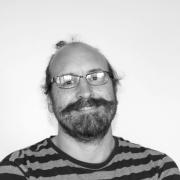#8, Closed for Installation, Sequence of Events
The first impression encountering Fiona Connor’s latest collection is of a form of tribute to those unsung assistants, technicians and other workers who install; the ancillary end of the art world, the often unpaid or nominally rewarded labour which sustains so many institutions. In this show Connor has presented a variety of cast bronze objects associated with installation, ranging from spirit levels and step ladders to the lid of a takeaway coffee cup. In addition to the works on view in Secession, she has also created two extra-mural projects with the institution. The content of the show could be taken as a sideways glance at those vertical economic structures, and the established, inexorable, ongoing devaluation of labour (unpaid internships; casualisation of academic positions; ‘payment in exposure/experience’) within the cultural sector. ‘It is a way of taking possession of something without directly disturbing the social fabric from where it was sourced…’ says Connor of her method, in an interview with Annette Sudbeck, the show’s curator. [1]
The bronze forms of these mundane items are unpainted, and mostly have an unfinished feel; a brush whose bristles are encrusted with resin or plaster; a folded-up plastic drip sheet are laid out in a quite sculptural arrangement, more or less evenly around the room. These are depictions, illustrations, ideals of grubby tools and ephemera. They have become abstracted, despite their being presented in an exhibition space. The space, a room once part of the former Secession caretakers’ apartment, is in contrast to the huge gallery downstairs where German artist Nora Schultz is showing, or even the converted basement spaces where UK born Rosalind Nashashibi’s paintings are on view. More evidently ‘homely’, the space’s walls, doors and other features have a patina of paint and marks of modification which call to mind some of Connor’s earlier projects.
Many visitors to Secession will be encountering Connor’s practice for the first time, and they are seeing her work alongside two other international artists of similar age and standing, who are having simultaneous, quite diverse shows in the varied spaces of the building. Connor’s work holds up well in this company, with a playful, even mischievous humour combining with the traditional medium and the more earnest socially engaged motives behind the work. Nashashibi is an expressionist figurative painter, whose works are intimate and introspective. Schultz a sculptor, installation and performance artist whose work incorporates found materials, much in the Arte Povera tradition: she often, as in this show, produces work of ambitious and epic proportions. Of the three, Connor is the artist producing work to a completely human scale.
Connor is perhaps best known for creating in situ highly detailed facsimiles of spaces, sometimes in part, sometimes in their entirety. A floor may have been raised a few inches, an interior or window of a gallery flawlessly replicated, so that where the space ends and the work begins is subverted and ambiguous. Here, Connor’s practice is still inhabiting the same space of doubt; the small upstairs room where the work is on show has some qualities reminiscent of her earlier installations, such as Minerva in Sydney in 2017, where she replicated the inner walls of the gallery’s exhibition space, into which she included displaced elements from other rooms in the building. In the room at Secession where the work is being shown, the windows have been retrofitted with another layer of glazing and one wall features a distinct pair of doors, thickly patinated with paint. I check with the attendant on duty, who confirms that these were in fact a permanent and original feature. In an institution as venerable as Secession, which has undergone extensive renovation in the last couple of years, quirks and irregularities can be just accepted as part of the fabric and history of the space. Pieces of the show crop up in the stairway leading to the exhibition room, and in the corner of the Klimt room down in the basement. This habit of letting the work seep out and escape its assigned exhibition space was a common practice among the artists of Gambia Castle, the mid 2000s Auckland art group with which Connor was associated early in her career. It spills over into the narratives of the adjacent public spaces, although interestingly not in those spaces where the other two artists in Secession are showing. With a practice so strongly identified with spatial displacement and intervention, it also provides an illustration of how that practice’s history can create an unexpected twist in its current presentation. Connor’s work has the potential to create unsettling narratives around the spaces in which she shows, even in what is apparently a self-contained collection of objects.
Whether, in 2019, the ‘boundaries’ of ‘art objects’, as proposed in the show’s accompanying publicity material are seriously in question is another matter, unless as a pushback against those prevailing reactionary tendencies continually relayed to us through the news cycle. Is such erudite parlour talk really the most pressing demand upon artists in the present day? Or is this in fact a kind of retrenchment, the protection of liberal values by means of doubling down on the formal aspects of art and exhibition making? A desire for stability, for determinacy, for faith in the institution? The bronze sculptures and extra mural projects in Connor’s show are presented as part of a wider, socially conscious project, specifically an appeal to reflect on the lot of the unregarded labouring classes. However, as we are becoming increasingly aware, even a once-subversive gesture of placing some of the works outside the space can be absorbed into the institutional language and become part of the formal institutional framework. As with many other practices operating under the aegis of institutional critique, Connor’s works here become products and beneficiaries of the self-same labour they seek to exalt and celebrate.
[1] https://www.secession.at/wp-content/uploads/2019/06/Fiona_Connor_Press_release-1.pdf







